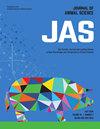感官评价应用的遗传学研究:以公猪杂种杂种的污点鉴别为例
IF 2.7
2区 农林科学
Q1 AGRICULTURE, DAIRY & ANIMAL SCIENCE
引用次数: 0
摘要
利用遗传选择来饲养完整公猪,可以提高生长和饲料效率,是一种有希望的替代阉割来减轻公猪污染的方法。选择性育种有可能帮助识别和选择具有降低公猪污染风险的遗传系。常见的表型是实验室测量粪臭素(SKA)和雄烯酮(ANON),即主要化合物负责猪的污染,在背膘。然而,存在另一种选择:由人类评估员进行感官评估。本研究的目的是:(1)估计不同评估者获得的感官评分(SENS)之间的遗传关系,(2)将这些评分与SKA和ANON相关联,(3)通过递归建模,建立SENS与因果性状的独立性,这里SKA和ANON保持不变,(4)结合不同的评估者,以便有效地选择野猪污染。数据包括1016条SKA、ANON和SENS(0 - 5)记录,这些记录来自10名训练有素的评估人员,他们对至少饲养到青春期的完整雄性背膘进行了评估,这些雄性在三个性能测试站测试了Pietrain ×商品杂交母猪的产品。遗传参数的估计采用限制估计最大似然法。SKA和ANON性状采用log (base 10)转化(SKAt和ANONt), SENS性状采用Snell转化(SENSt)。SKAt的遗传力估计为0.52,ANONt的遗传力估计为0.53,SENSt的遗传力估计范围为0.07至0.30。部分SENSt与SKAt(最高达0.87)和ANONt(最高达0.61)之间存在中等至高度的遗传相关性。遗传力和相关性表明,某些SENSt可用于抗公猪污染的选择。基于后验递归模型研究SENSt与SKAt和ANONt的独立性,发现遗传方差的减少幅度很大:高达71.08%。然而,一些SENSt仍然具有中度遗传性(0.04至0.19),表明独立于SKAt和ANONt的遗传变异。这反映了一些可能与SKA或ANON无关的遗传化合物被感知。最后,评估器的组合允许,这里显示了三个评估器,获得0.40的高遗传率,与高遗传和表型相关性相关。此外,这些结果证明了使用几个受过训练的评估员的感官分数来选择野猪污染的潜力。本文章由计算机程序翻译,如有差异,请以英文原文为准。
Genetic investigations into the use of sensory evaluation: The case of boar taint discrimination in Pietrain sired crossbreds
Using genetic selection for raising intact boars, which improves growth and feed efficiency, is a promising alternative to castration for mitigating boar taint. Selective breeding has the potential to help to identify and select for genetic lines with a reduced risk of boar taint. Common phenotypes are laboratory measurements of skatole (SKA) and androstenone (ANON) i.e., the major compounds responsible for boar taint, in backfat. However, an alternative exists: sensory evaluation by human assessors. The objectives of this study were (1) to estimate the genetic relationships among sensory scores (SENS) obtained by different assessors, (2) to correlate these scores with SKA and ANON, (3) to establish the independence of SENS from the causal traits, here SKA and ANON, by recursive modeling, holding those constant, and (4) to combine different assessors to allow an efficient selection against boar taint. Data included up to 1016 records of SKA, ANON and SENS (0 to 5) from 10 trained assessors on the backfat of intact males reared at least until puberty at three performance testing stations testing the products of Pietrain × commercial crossbred sows. Genetic parameters were estimated using restricted estimate maximum likelihood. Traits SKA and ANON were log (base 10) transformed (SKAt and ANONt) and SENS traits were Snell transformed SENS (SENSt). Heritability estimates were 0.52 for SKAt and 0.53 for ANONt, those for SENSt ranged from 0.07 to 0.30. Moderate to high genetic correlations between some SENSt and SKAt (up to 0.87) and ANONt (up to 0.61) were found. Heritabilities and correlations indicated that some SENSt could be used to select against boar taint. Studying the independence of SENSt from SKAt and ANONt based on a posteriori recursive model revealed a large range of reductions of genetic variance: up to 71.08 %. However, some SENSt remained moderately heritable (0.04 to 0.19) indicating independent genetic variance from SKAt and ANONt. This reflects that some heritable compounds potentially not related to SKA or ANON are perceived. Finally, the combination of assessors allowed, here shown with three assessors, to obtain a high heritability of 0.40, associated to high genetic and phenotypic correlations. Moreover, these results demonstrate the potential of using the sensory scores of several trained assessors for selection against boar taint.
求助全文
通过发布文献求助,成功后即可免费获取论文全文。
去求助
来源期刊

Journal of animal science
农林科学-奶制品与动物科学
CiteScore
4.80
自引率
12.10%
发文量
1589
审稿时长
3 months
期刊介绍:
The Journal of Animal Science (JAS) is the premier journal for animal science and serves as the leading source of new knowledge and perspective in this area. JAS publishes more than 500 fully reviewed research articles, invited reviews, technical notes, and letters to the editor each year.
Articles published in JAS encompass a broad range of research topics in animal production and fundamental aspects of genetics, nutrition, physiology, and preparation and utilization of animal products. Articles typically report research with beef cattle, companion animals, goats, horses, pigs, and sheep; however, studies involving other farm animals, aquatic and wildlife species, and laboratory animal species that address fundamental questions related to livestock and companion animal biology will be considered for publication.
 求助内容:
求助内容: 应助结果提醒方式:
应助结果提醒方式:


